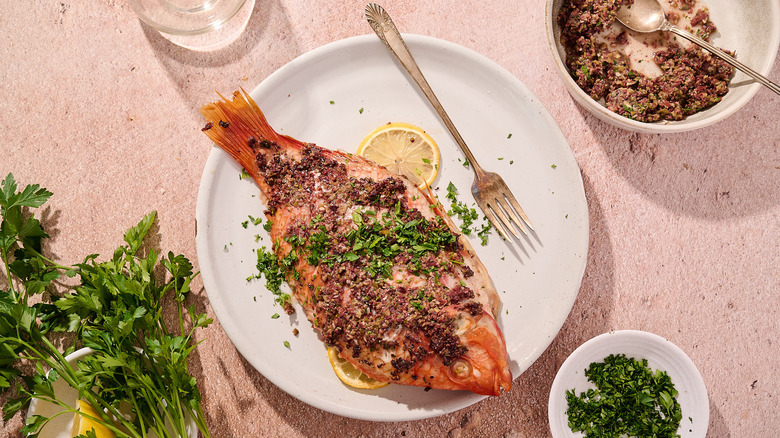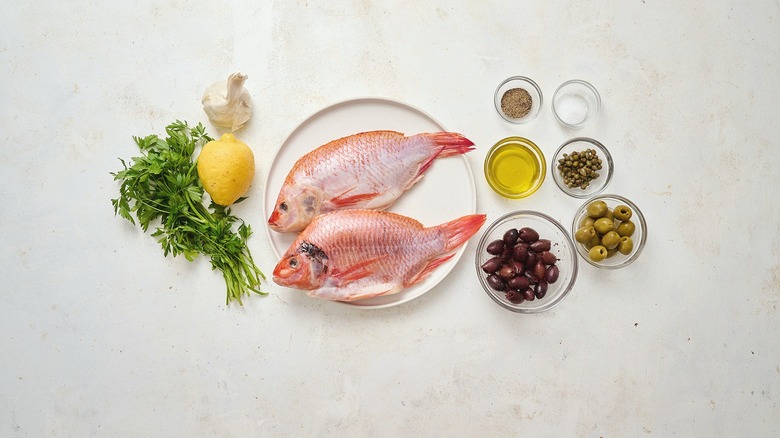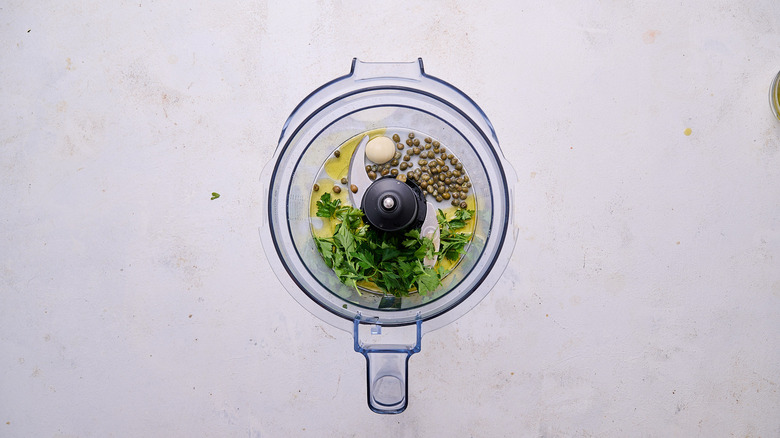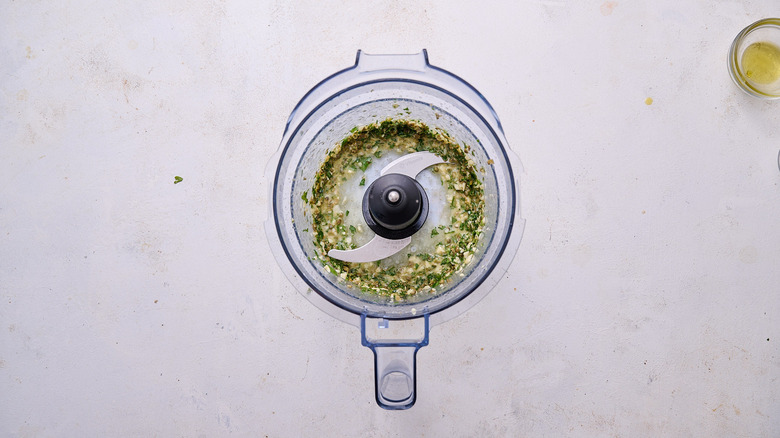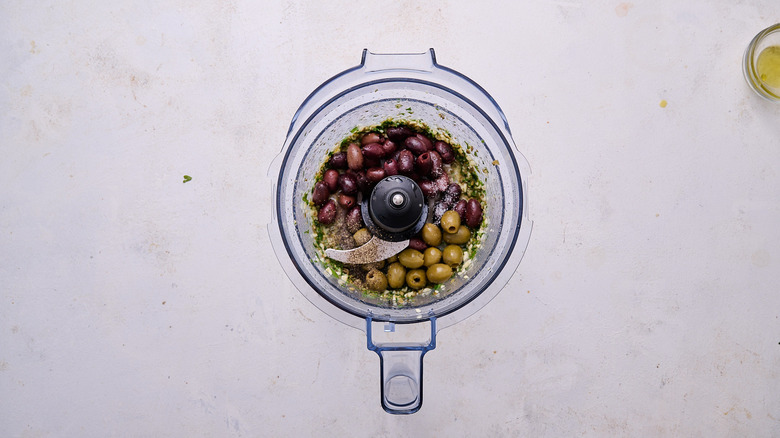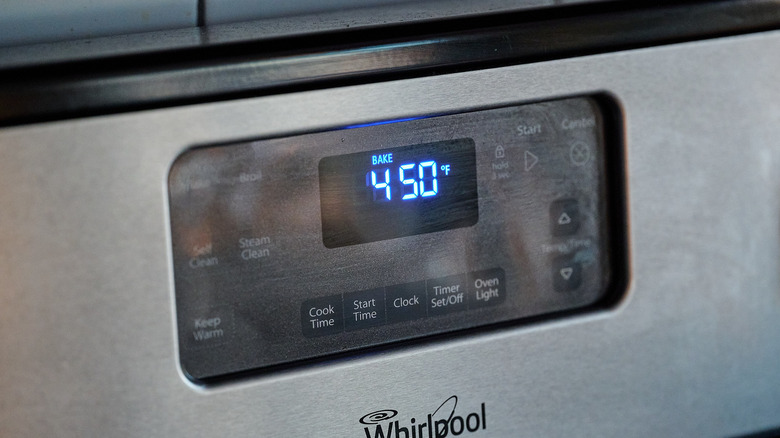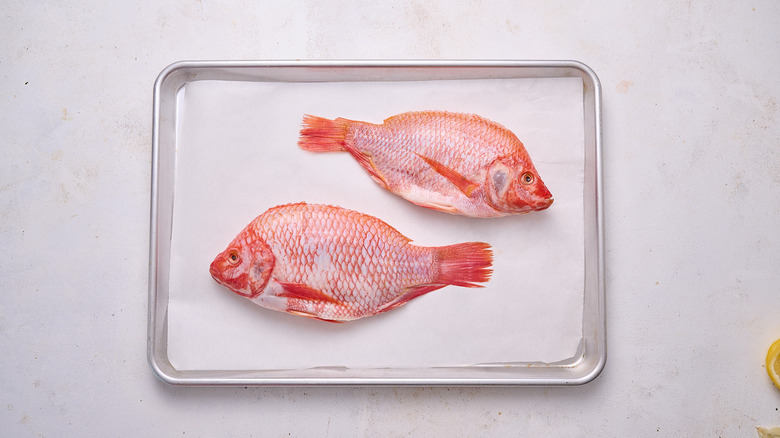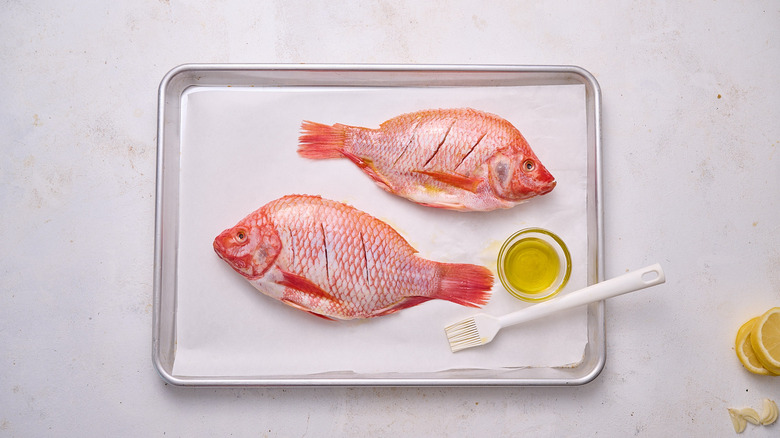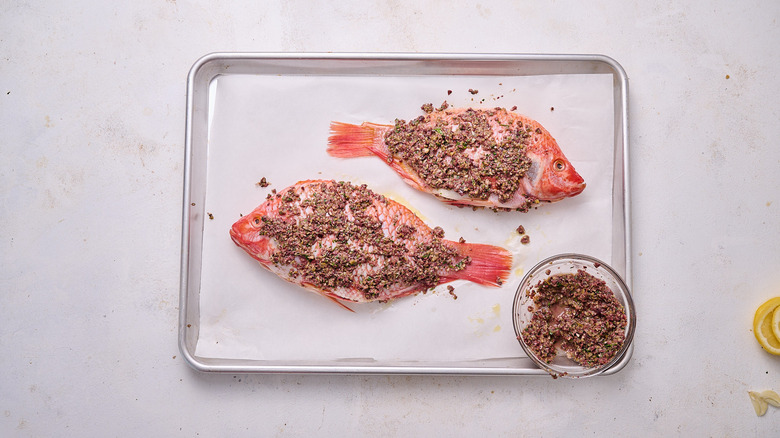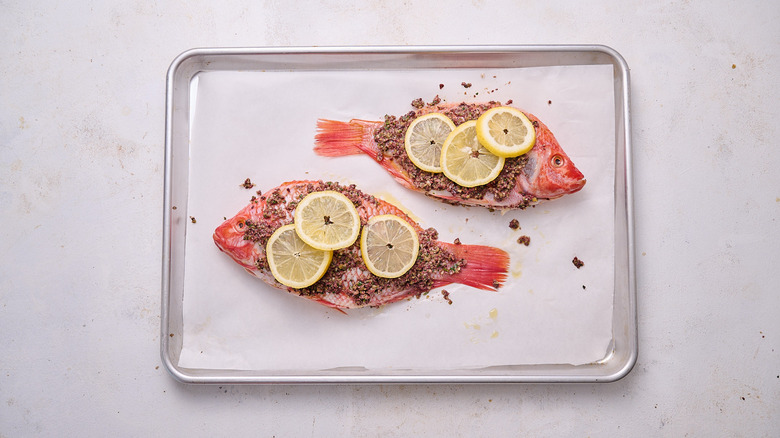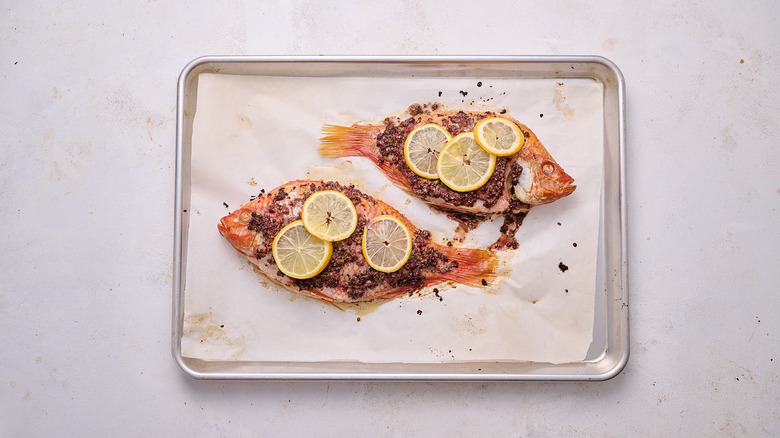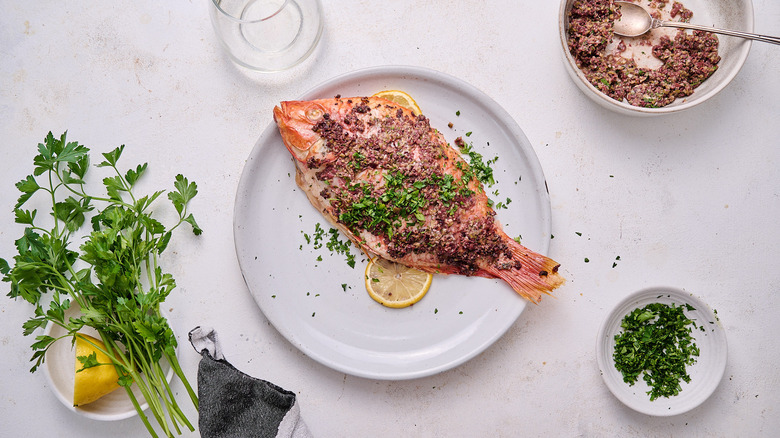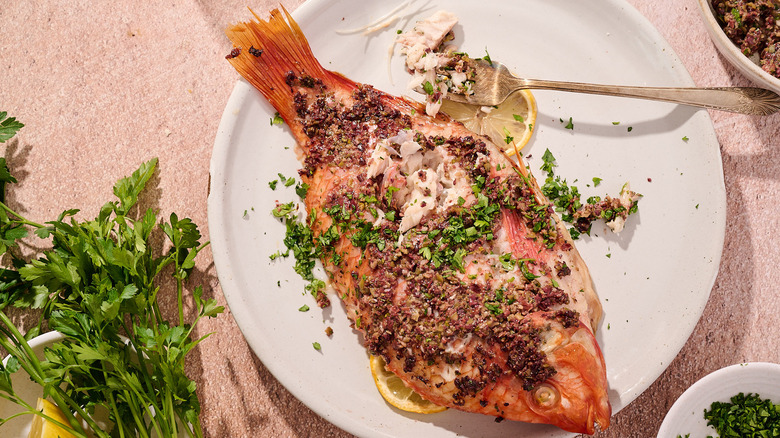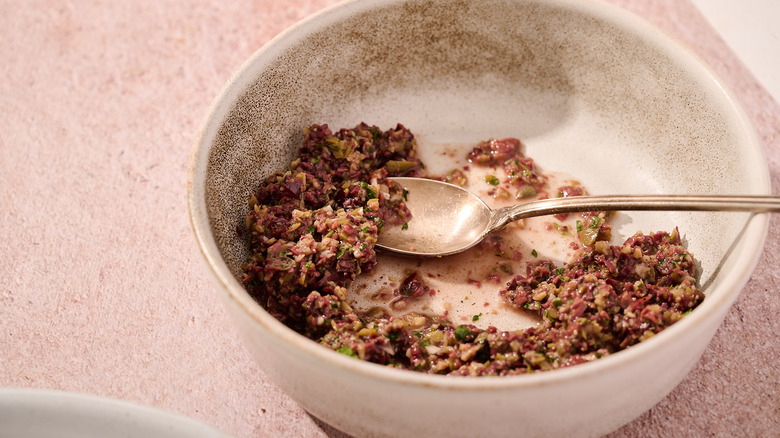Greek Baked Tilapia With Simple Tapenade Recipe
Being a country surrounded by endless expanses of crystalline blue waters, much of Greek cuisine relies on the fresh catches of the Mediterranean Sea. Octopus, for example, is hung to dry along the harbors and later used in bright summer appetizers. Branzino is native to the Mediterranean and famously used in Grecian cuisine for whole-roasted meals; so notable, in fact, that the method of cooking is usually referred to as "Greek-style." Coated in local olive oil, dressed with lemon, and doused in parsley, onions, and tomatoes, it's a delicious part of a cuisine rich in fresh ingredients and easy preparation — not to mention, it's fun to dig into, bringing your friends and family close for an intimate meal.
Recipe developer Michelle McGlinn draws inspiration from traditional Greek ingredients and preparation in this recipe for baked tilapia with simple tapenade. Not a typical fish for eating whole, tilapia's unique flavor requires strong additions like garlic, lemon, and olives. By baking the tilapia with a freshly-made tapenade, the fish transforms into a juicy, robust meal you can dig into straight from the oven. A surprisingly easy meal, this whole-roasted tilapia makes for both a light weeknight dinner and a main course at dinner parties alike. If you (or your dinner party guests) aren't keen on eating around the bones, we included some tips to make it feel like you've lived on the coast of Greece your whole life.
Gathering ingredients for Greek baked tilapia with simple tapenade
The tapenade used in this recipe is fairly straightforward — a classic Mediterranean take on the olive pâté. You'll first need pitted kalamata and green olives, though you can omit one or the other or add black olives depending on preference. You'll also need capers, as well as lemon juice, parsley, olive oil, garlic, salt, and pepper, some of which you'll use again for the fish.
Next, you'll need a few whole tilapia. Each tilapia serves two people, so for four servings you'll only need two fish. From there, you'll just need lemon slices.
Step 1: Begin making the tapenade
To make the tapenade, add the garlic, capers, parsley, lemon juice, and olive oil to a food processor.
Step 2: Pulse to chop
Pulse until finely chopped.
Step 3: Add the remaining tapenade ingredients
Add the olives, salt, and pepper and pulse until finely chopped. Set the tapenade aside.
Step 4: Preheat the oven
Preheat the oven to 450 F.
Step 5: Prepare the fish for baking
Place the fish on a parchment-lined sheet tray and slice 3 slits into each belly.
Step 6: Brush with oil
Brush each fish on both sides with olive oil.
Step 7: Add the tapenade
Add the tapenade in and around the fish, stuffing some into the cavity.
Step 8: Add the lemon and garlic
Place the lemon and garlic slices on top of the fish and in the cavity.
Step 9: Roast fish until flaky
Roast the fish for 18-20 minutes, until flaky.
Step 10: Sprinkle with parsley to serve
To serve, sprinkle with chopped parsley.
Greek Baked Tilapia with Simple Tapenade Recipe
Entertain your guests with the perfect feast - a whole baked tilapia, topped off with a zesty olive tapenade.
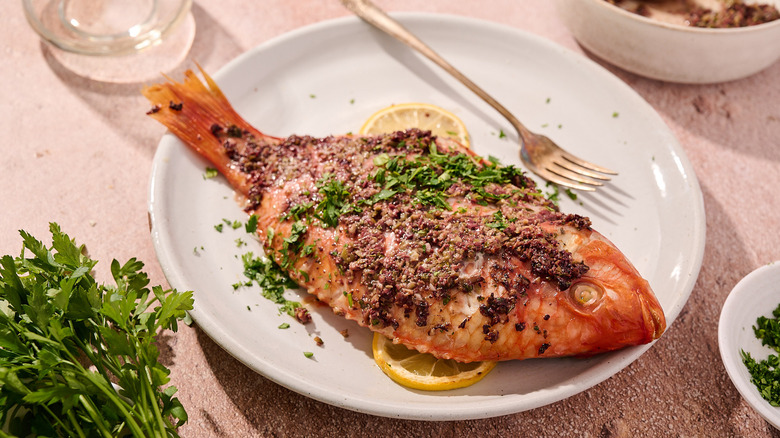
Ingredients
- For the tapenade
- 2 cloves garlic
- 2 tablespoons capers
- ¼ cup parsley, stems removed
- Juice from ½ lemon
- 2 tablespoons olive oil
- 1 cup pitted kalamata olives
- ½ cup pitted green olives
- ⅛ teaspoon salt
- ⅛ teaspoon pepper
- For the fish
- 2 whole tilapia fish, cleaned and gutted
- 1 tablespoon olive oil
- 6 thin slices lemon
- 2 cloves garlic, thinly sliced
- 2 tablespoons finely chopped parsley, for serving
Directions
- To make the tapenade, add the garlic, capers, parsley, lemon juice, and olive oil to a food processor.
- Pulse until finely chopped.
- Add the olives, salt, and pepper and pulse until finely chopped. Set the tapenade aside.
- Preheat the oven to 450 F.
- Place the fish on a parchment-lined sheet tray and slice 3 slits into each belly.
- Brush each fish on both sides with olive oil.
- Add the tapenade in and around the fish, stuffing some into the cavity.
- Place the lemon and garlic slices on top of the fish and in the cavity.
- Roast the fish for 18-20 minutes, until flaky.
- To serve, sprinkle with chopped parsley.
Nutrition
| Calories per Serving | 414 |
| Total Fat | 20.4 g |
| Saturated Fat | 3.9 g |
| Trans Fat | 0.0 g |
| Cholesterol | 112.5 mg |
| Total Carbohydrates | 16.9 g |
| Dietary Fiber | 5.3 g |
| Total Sugars | 3.6 g |
| Sodium | 778.4 mg |
| Protein | 47.6 g |
How do I serve a whole baked tilapia?
Eating whole fish can be mystifying if you've never done it before; the truth is, though, that it's as simple as digging in. Remind your guests — and yourself — to eat slowly and mindfully, because the fish is still fully boned. The bones will be obvious but thin enough that one or two may go unnoticed on your fork. If this happens, don't panic, simply remove the bone when you notice it while chewing. To help your confidence, do most of your digging in the meaty middle filet, avoiding the smallest bones located on the spine, near the tail, and around the head. When you've eaten the meat of the initial filet, grab the tail and spine and remove in one piece, revealing the now-boneless lower filet.
Unlike a typical filet, which might be served on top of other sides, whole fish is usually eaten in small bites on its own, accompanied by sides to be enjoyed separately. Great sides to pair whole fish with will be filling and great on their own, not needing to be on the same fork as your fish. We recommend pairing with a lemony, leafy green salad or a light summer soup. You can also serve with roasted new potatoes or latkes. An easy pairing option is grilled vegetables, especially in-season finds like asparagus, tomato, summer squash, and mushrooms.
What can I use extra tapenade for?
Depending on the size of your fish, you may have extra tapenade after baking. If you plan to use your remaining tapenade, be careful when dressing your fish. To avoid cross-contamination, spoon the tapenade over the fish and work into the cavities using your hands, using a new spoon or clean hands if you need to add more. Once the fish is coated and filled with tapenade, store the rest in an airtight container until ready to use.
You can use the tapenade on warm crusty bread, which makes a great, simple side dish for the fish. You can also use it as a snack or appetizer on crackers, pita, or naan. You can combine it with hummus or mix it into labneh for a more filling snack, or bake it into feta for a gooey pre-party app. Tapenade is also delicious on sandwiches like ham and cheese or tuna salad. And if you really like tapenade, give it a try on top of burgers or mixed into pasta as a sauce.
